- Accueil
- Base de données
- 29
- 1st July 1941
1st July 1941
Vickers WELLINGTON Mk IC
R1413 (code OJ-B)
Cargo port - Saint-Marc shoreline - Brest (29)
(contributors : Daniel Dahiot, Jonathan Ives, Dr Keith Gould, Philippe Dufrasne)
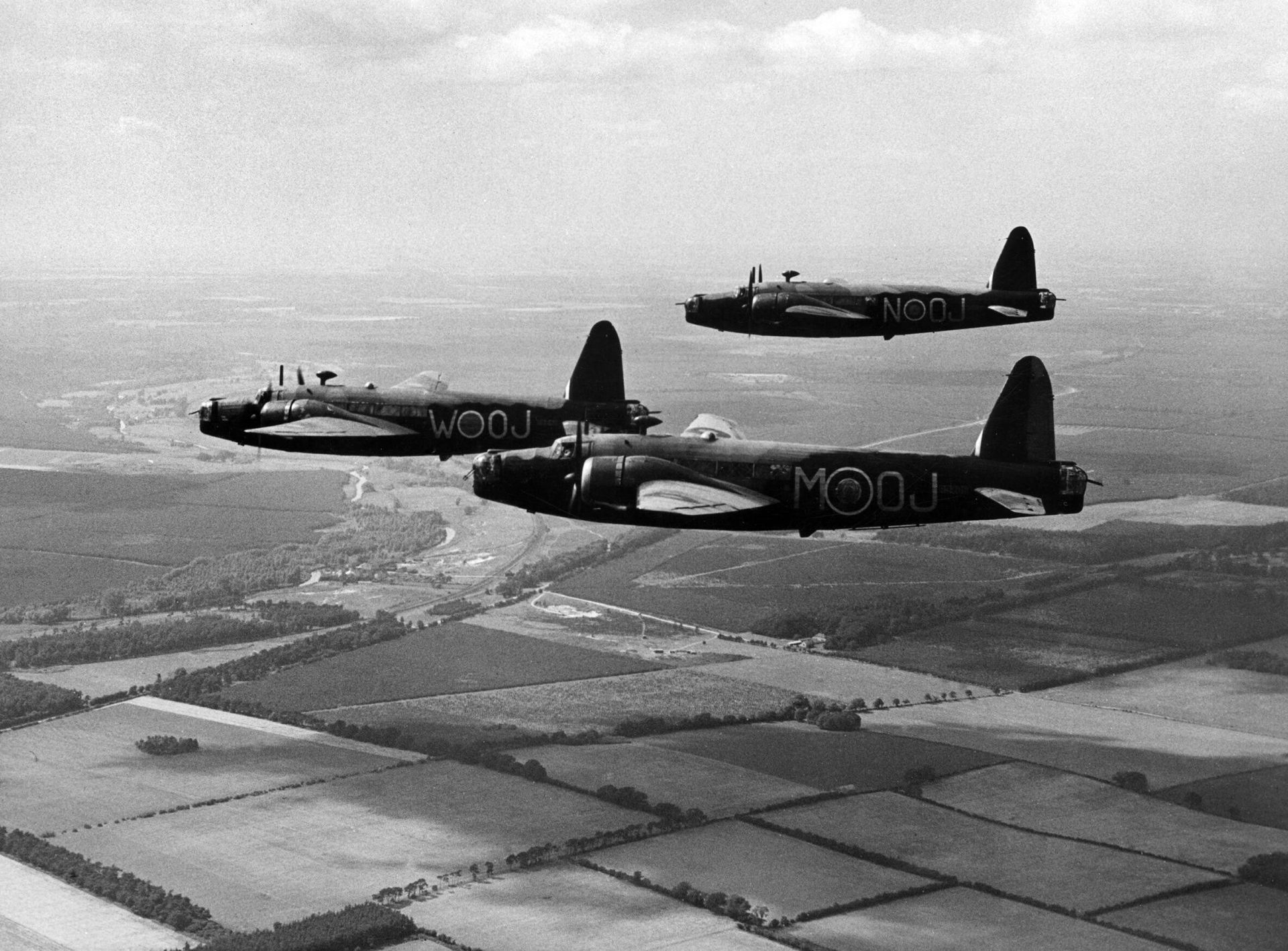
Vickers Wellington Mk IC of no 149 Squadron RAF circa August 1940.
© IWM (HU 107812) - public domain
Crew (149 Squadron RAF 'East India')
All crew members buried in Brest Kerfautras cemetery
Pilot Officer (pilot) Standish Locksley ST. VINCENT - WELCH, (service number 40142, RAAF), aged 23, K.I.A.
Son of Dr Kenyon and Verlie Adair St-Vincent - Welch, from Shaw, New South Wales, Australia.
Plot 40, Row 1, Grave 7
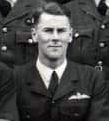
Sergeant (pilot ?) William Mervyn SYMMONS (service number 404129, RAAF), aged 22, K.I.A.
Son of William Herbert and Josephine Symmons, from Hamilton, Queensland, Australia.
Plot 40, Row 1, Grave 25
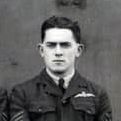
Sergeant (observateur) William James MEGRAN (service number 901032 RAFVR), K.I.A.
Son of James and Gladys Kathleen Megran, from Horfield, Bristol, United Kingdom.
Plot 40, Row 1, Grave 21

Sergeant (opérateur radio, mitrailleur) Robert Harland CRAFTS, (service number 18074A, RCAF), aged 24, K.I.A.
Born 19 November, 1917 in Kingsville, Ontario, Canada.
Plot 40, Row 1, Grave 19
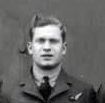
Sergeant (opérateur radio, mitrailleur) Cecil Charles REIDMULLER, (service number 979560, RAFVR), aged 23, K.I.A.
Son of Auguste and Emma Mary Elisabeth Reidmuller, nephew of Miss G. Cecil, from Haverfordwest, Pembrokeshire, UK.
Plot 40, Row 1, Grave 8

Flight Sergeant (mitrailleur) Anthony Robert James HARRISON, (service number 812347, RAF Aux.), aged 20, K.I.A.
Son of Alexander and Amelia G. Harrison, Maidstone, Kent, UK.
Plot 40, Row 1, Grave 29
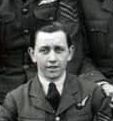
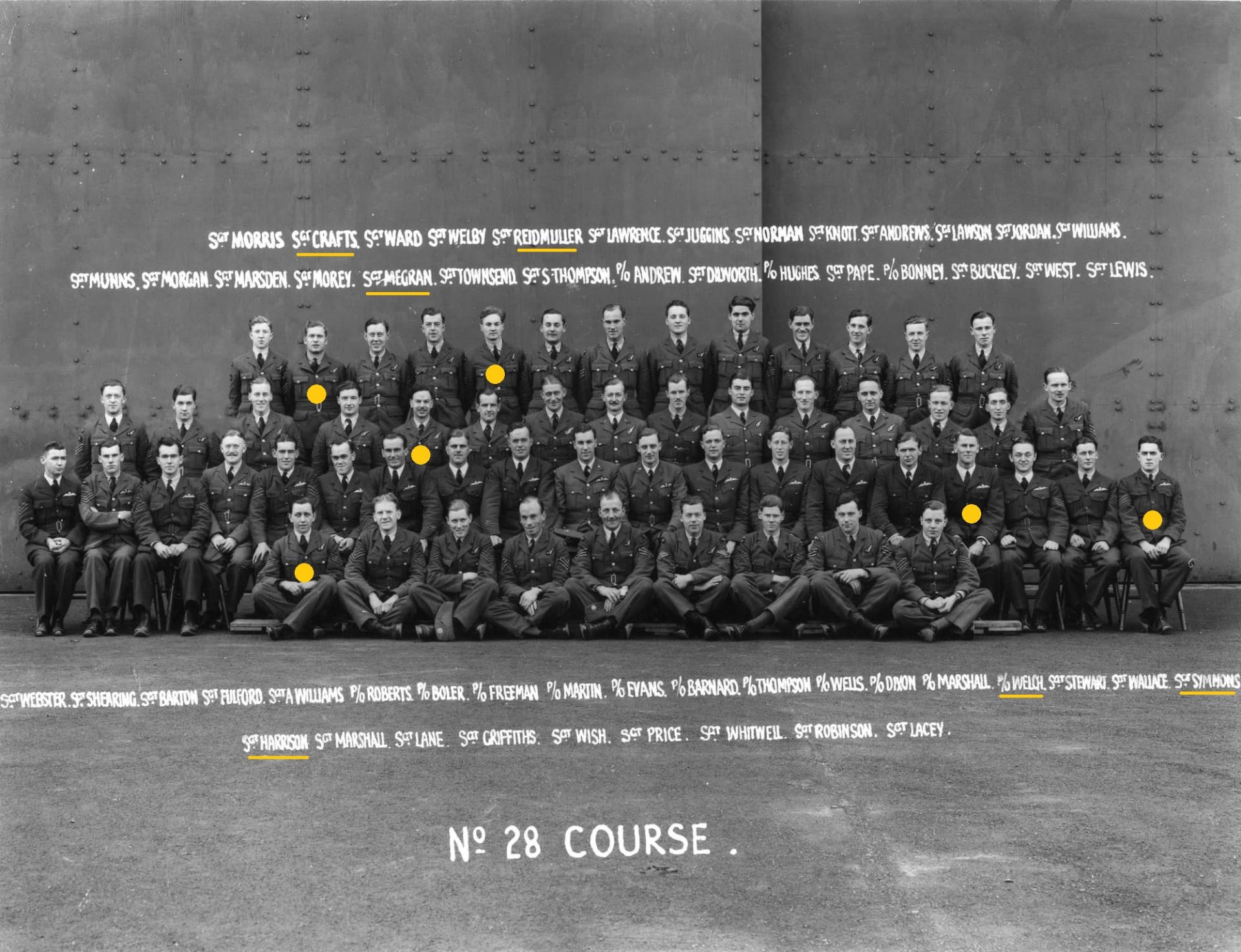
The crew of Wellington R1413 during their training at no 11 OTU (Operational Training Unit)
Photo with courtesy of Dr Keith Gould
THE STORY
• The attack
This Tuesday, July 1, 1941, 63 Wellington bombers took off from England for a bombing mission targetting the German cruisers Scharnhorst, Gneisenau and Prinz Eugen, anchored in the harbor of Brest. This group of Wellingtons of the Royal Air Force was divided into two sub-groups, groups II and III, a 1st group of 5 aircrafts having been sent to Cherbourg. A source indicates that the composition of these planes was as follows :
Group II :
- 11 aircrafts of No 9 Squadron (plus a Wellington sent to bomb the docks and ships in the harbor of Cherbourg)
- 10 aircrafts of No 99 Squadron
- 9 aircrafts of No 101 Squadron
- 15 aircrafts of No 149 Squadron.
Group III :
- 8 aircrafts of No 311 Squadron (plus 4 Wellington sent over Cherbourg)
- 10 aircrafts of No 99 Squadron.
The raid was carried out between 11:11 p.m. (July 1) and 5:05 a.m. (July 2). The results were difficult to see because of the haze and smoke on the harbor. The tonnage of bombs dropped that night was :
On harbor facilities and Scharnhorst (aircrafts of Group II) :
- 31.9 tons of 2,000 lb bombs including three 2,000 lb A.P. bombs ("Armour Piercing" i.e. penetrating bombs)
- 31,9 tons of 1,000 lb bombs
On Prinz Eugen (aircrafts of Group III) :
- 30.2 tons divided into 7 x 1,000 lb bombs, 1,156 x 500 lb SAP bombs and 11 x 250 lb SAP bombs (SAP: "Semi Armour Piercing")
Two Wellingtons were lost during this raid : Wellington Mk IC R1343 was one of these two aircrafts, the other being Wellington Mk IC R1408. The Wellingtons of No. 149 Squadron departed from RAF Mildenhall, Suffolk, where they had been based since April 1937. Since January 1939, this Squadron had been equipped with Wellington Mk I, IA and IC, which had replaced the old Handley Page Heyford. These Wellingtons were used until December 1941, then were replaced by Short Stirlings. Our Wellington R1343 was the first to take off, at 10:38 p.m. on July 1st. He was unfortunately shot down that night. Distraught, the plane crashed near the Prinz Eugen, on the rocks of the commercial port where it remained exposed for a long time. The crew was buried on July 7, 1941 in the Kerfautras cemetery in Brest, “coming from the maritime hospital” according to the cemetery’s convoy register.
The Wellington Mk. IC R1408 took off at 10:41 p.m. According to 149 Squadron ORB, two layers of haze on the ground and about 5,000 feet, above Brest, made identification of any targets impossible. As a result, some aircrafts returned to base with their load of bombs, others dropped them. As an example, Wellington T2737 (code OJ-A) remained nearly 45 minutes above Brest without releasing its bombs. The Wellington W5718 (code OJ-O) also brought back its bombs ; he remained 25 minutes (from 1:20 to 1:45 am) at 9,500 feet above Brest but did not release its load due to the smokescreen. It then headed towards Cherbourg, the second target, but did not drop any bombs either due to similar conditions. The ORB revealsto us that the other planes dropped their bombs in one stick.
• On the German side
The Prinz Eugen was hit by a bomb which penetrated the port bow, exploded in the depths and ravaged the central gunnery and navigation stations. There were 50 (or 51) people killed on board, including the second in command, the 1st Officer. Otto Stoss.
- Extract from "Kreuzer Prinz Eugen...unter 3 Flaggen" (Paul Schmalenbach, 1978)
July 2, 1941
12:40 a.m. : air alert
01:44 a.m. : hit by a bomb from a string of six. The bomb pierces the gunwale (the gutter furring) on the port side, the battery deck, the intermediate deck as well as the armored deck and the upper deck, in section X. The forward fire control station, the command center, the artillery switching station and the gyrocompass room are seriously damaged, the power plant 3 is less damaged, shrapnel passes through the double wall inside and outside, so that water from the dock - pre-flooded (water intended for cooling and fire-fighting!) - enters the ship to a height of about 1 meter.
42 dead were found in the three days that followed. 31 seriously injured people were sent to hospitals in Brest and near Paris, many of whom still died, sometimes after several weeks. In total, 60 comrades were victims of the attack, including the second officer present in the command center, Fregattenkapitän Otto Stoß. Most of the dead were buried on July 6 in the Brest-Kerfautras* cemetery.
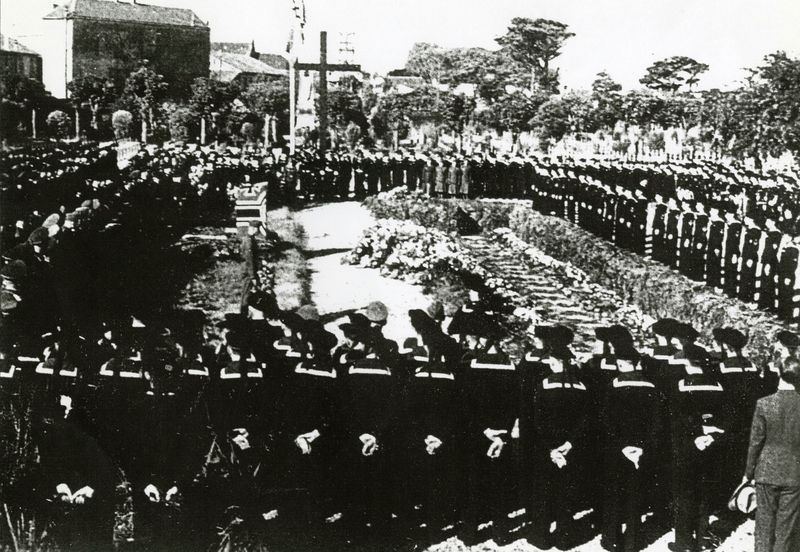
Funeral of the 50 German victims in Brest-Kerfautras after the bombardment of the "Prinz Eugen
Photo © Y.Caroff collection via Archives de Brest (reference 12Fi2365)
The material consequences of the hit are also disastrous. As the aft fire control station and the corresponding switching station are not equipped, the ship is practically deprived of any possibility of naval target artillery guidance and is therefore not operational. Discussions with the Brest arsenal establish that repair work on the ship cannot be completed before November 10. Refitting the cabling will take even more time.
This is why on July 7, a telex was sent to the Oberkommando der Kriegsmarine requesting that the fire guidance system parts (planned for other ships under construction) be released for assembly in Brest. These include not only the parts of the artillery guidance installation already mentioned, but also the two front flak fire control stations with corresponding computers, electrical cabinets and accessories. On July 10, the Oberkommando der Kriegsmarine authorized the installation of the missing devices - A diesel-electric railcar from the French railways was installed in front of the ship as a power plant. During the fall, a steam locomotive will be added as an auxiliary boiler for heating.
On July 24, 21 leavers were injured while rescuing French people buried during an air attack.
According to the time of immobilization which will certainly last until December, part of the crew is temporarily disembarked: The I. AO (First Artillery Officer), and part of the crew of the naval target artillery service return to Germany for gunnery practice on sister ship ADMIRAL HIPPER. Part of the crew leaves the ship to follow non-commissioned officer training, many junior non-commissioned officers will follow senior non-commissioned officer training courses. Some return on board having passed the exam.
* Transferred in 1966 to the Ploudaniel-Lesneven military cemetery, north of Brest, the latter inaugurated on September 7, 1968.
- Extrait du rapport sur le bombardement du "Prinz Eugen" dans la nuit du 1 au 2.7.1941 – Journal de bord (Kriegstagebuch).
Combat medical report from the cruiser Prinz Eugen concerning the English air attack of July 2, 1941.
On 2.7.1941, the air alert was given on board at 00:45, because English aviators were trying to attack Brest. At 1:45 a.m., a stick of bombs fell in the immediate vicinity of the ship in dry dock, masked by camouflage nets and smoke. One of these bombs (probably a 500 kg armor-piercing bomb) struck the upper deck on the port side, at the level of sections IX and X, passed through the upper deck, the battery deck, the middle deck, the armor deck and exploded between the lower and upper decks. The forward fire control position, the forward fire switching station, the forward fire direction position and the command center were partly completely destroyed and the soldiers there were either killed or poisoned by the fumes or burnt.
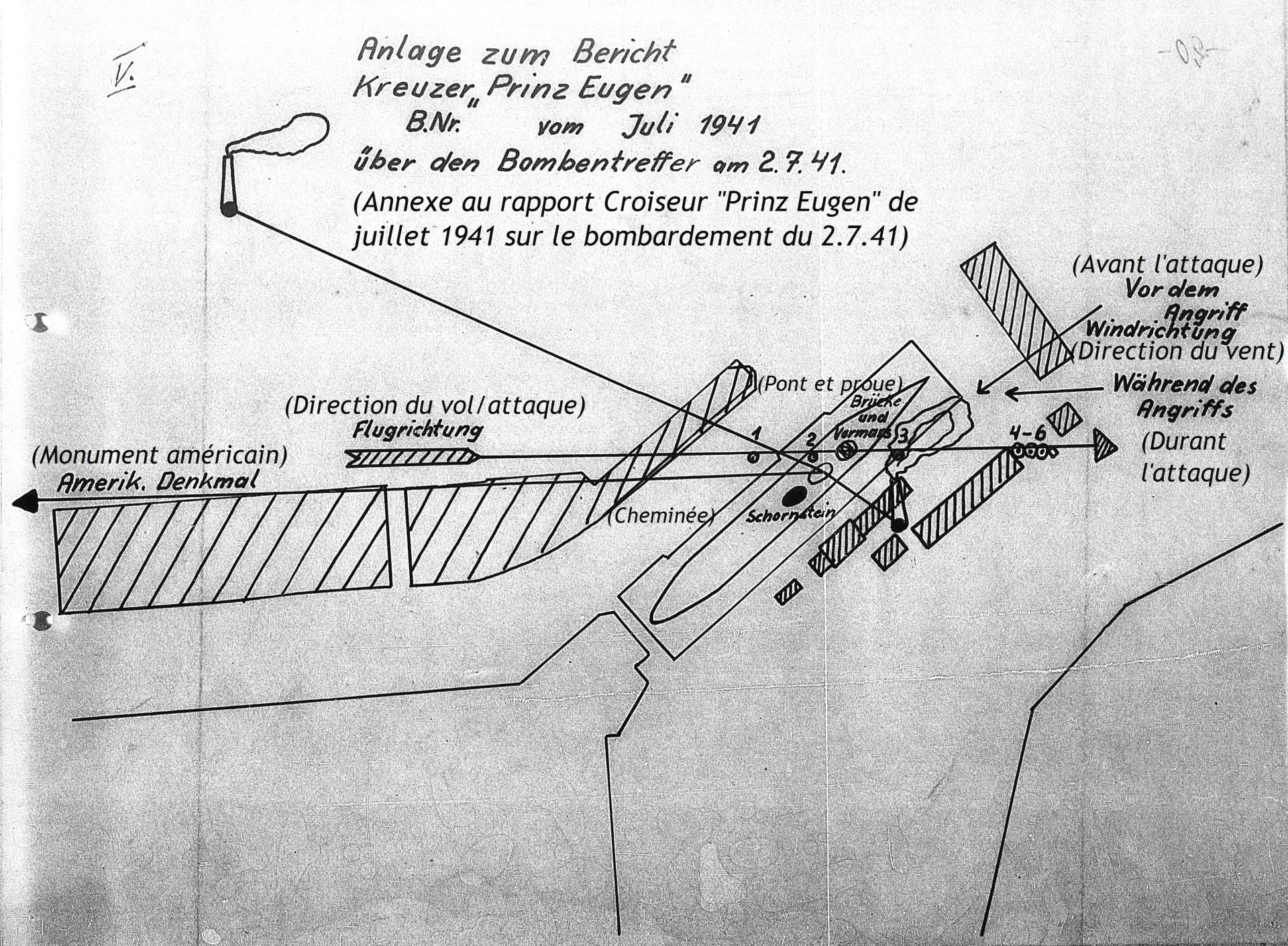
Scheme of the attack - Report from the cruiser Prinz Eugen
Sources :
• Roland Bohn - "Raids aériens sur la Bretagne durant la seconde guerre mondiale".
• Brest 39/45 - Chronologie d'une guerre
• "The Bomber Command War Diaries : An Operational Reference Book 1939-1945" - Authors, Martin Middlebrook, Chris Everitt
• "A l'ombre de deux clochers: la vie de tous les jours à Plouzané de 1920 à 1951", Yvonne Briant-Cadiou (Pages. 191-192).- Editions nouvelles du Finistère, 1994
• Archives Municipales de Brest (Finistère)
• Kreuzer Prinz Eugen...unter 3 Flaggen / Paul Schmalenbach, 1978
• Prinz Eugen - Kriegstagebuch
APPENDICES
Extract from document AIR-27-1001-14 (Operational Record Book no 149 Squadron RAF) for the date of July 1st, 1941
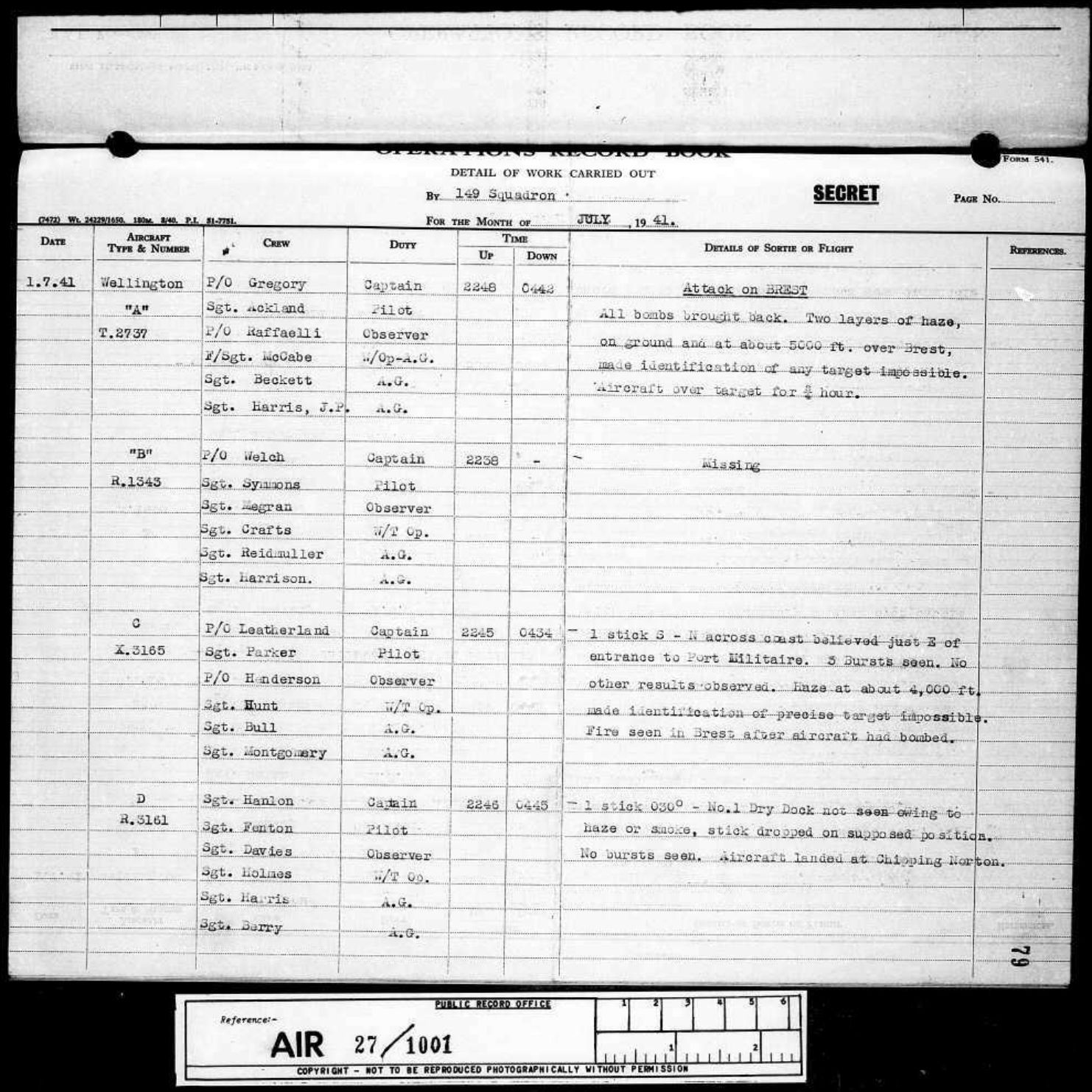

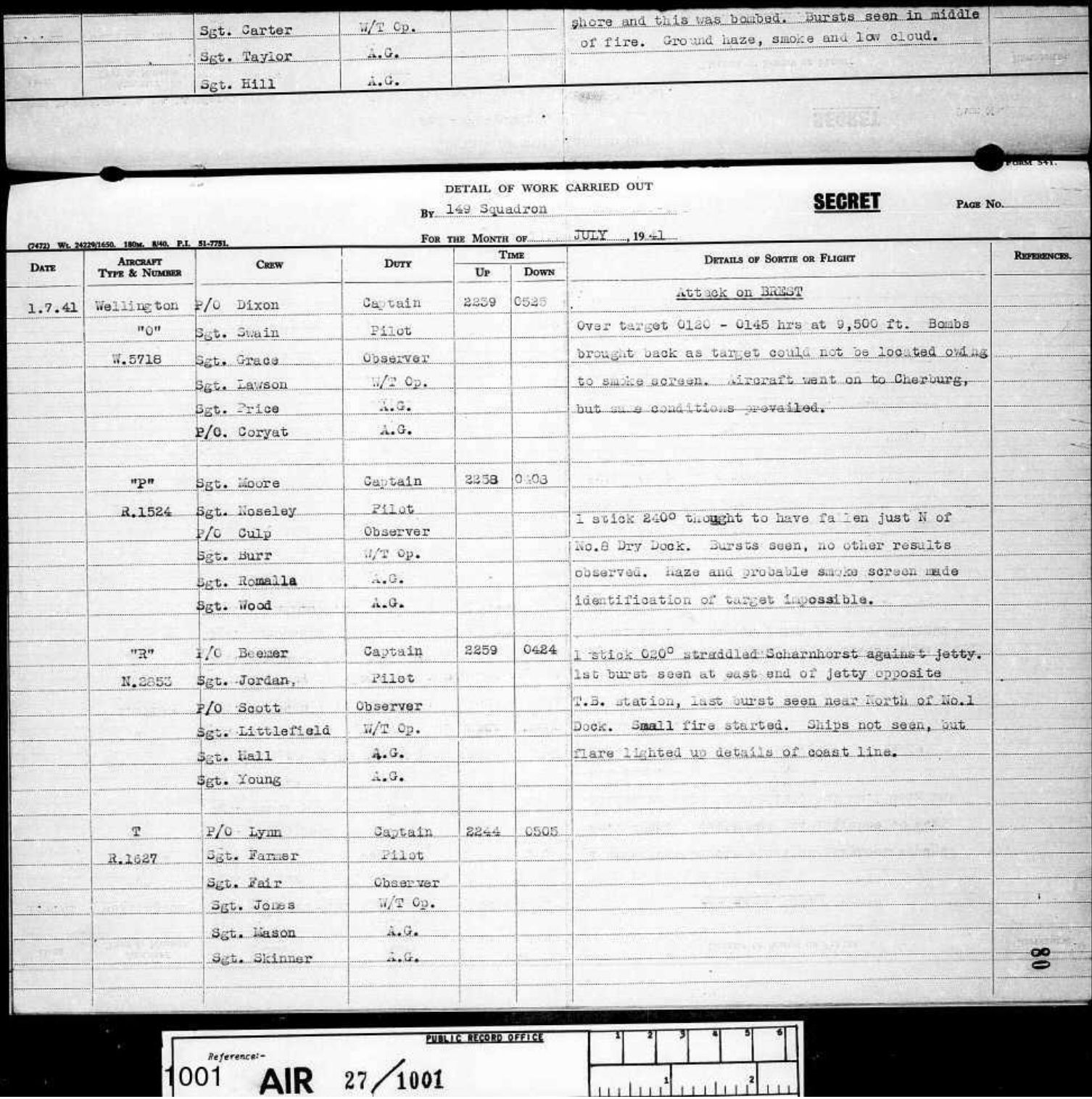
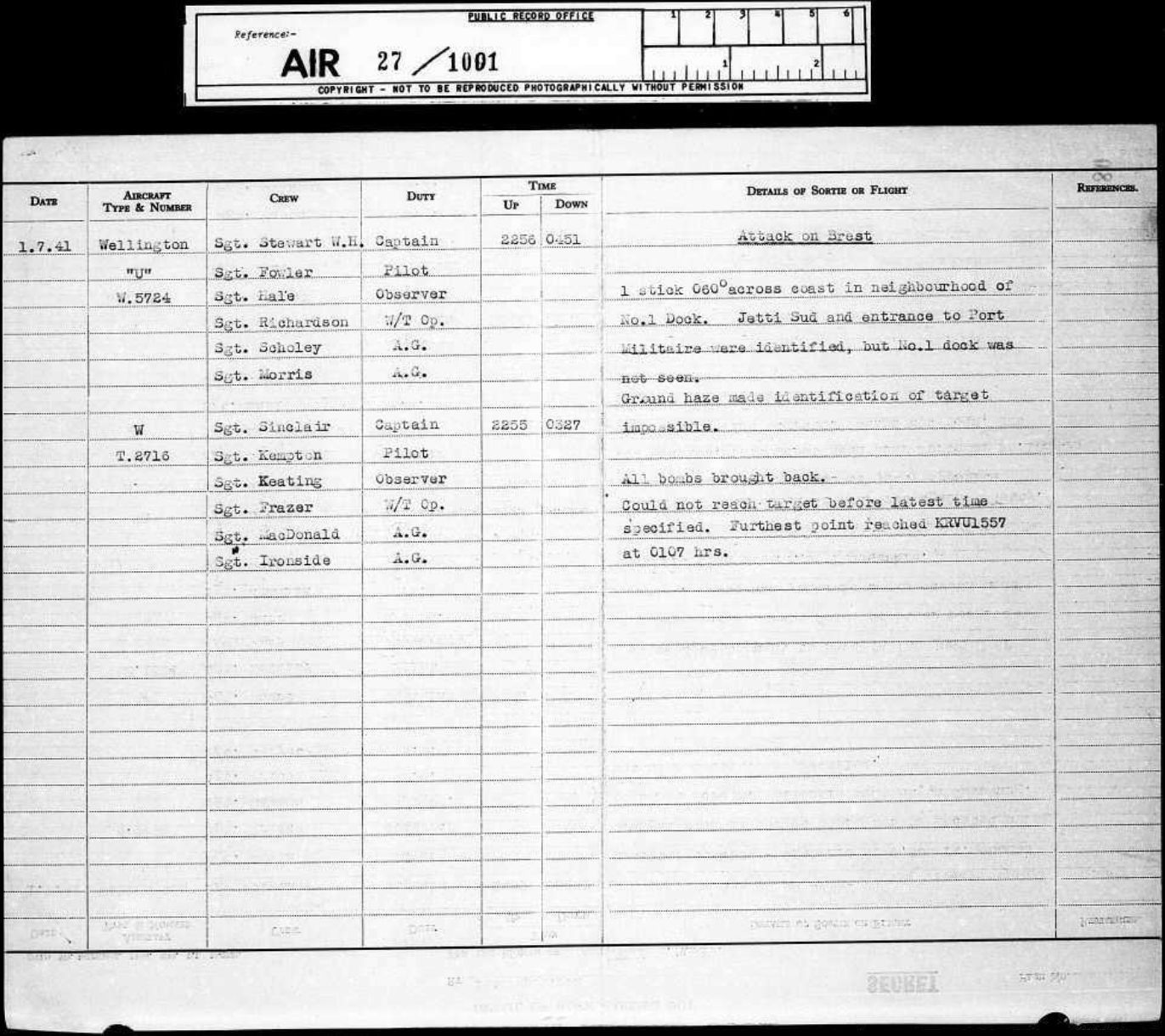

Ajouter un commentaire